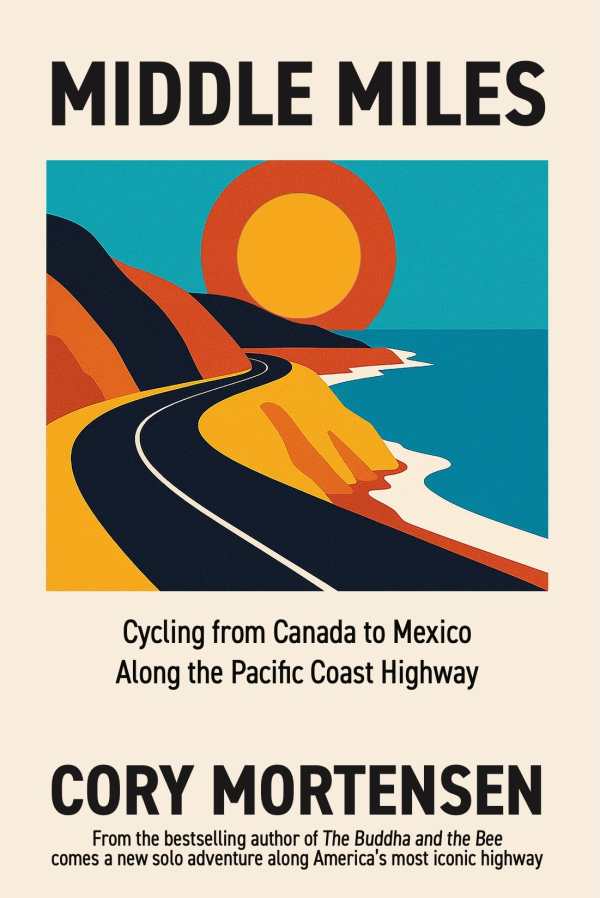Middle Miles
Cycling from Canada to Mexico Along the Pacific Coast Highway
Middle Miles is a resonant memoir that captures the landscapes, people, and meditations encountered during a long ride.
Cory Mortensen’s spirited travel memoir Middle Miles chronicles the various logistics, challenges, enjoyments, and reflections behind his solo bicycle trip from Canada to Mexico.
In July of 2023, Mortensen decided to turn a visit to Oregon into a monthlong bike trip down the Pacific Coast Highway. Having ridden from Minneapolis to California two decades earlier, fifty-three-year-old Mortensen was familiar with the endurance required for cross-country biking. Despite the passage of time, he adhered to his previous mindset and “packed light, trusted in [his] abilities, and embraced the bewilderment ahead.”
The trip’s itinerary is illustrated in clear-cut graphics, with each chapter highlighting destination points and the anticipated mileage and elevation. The course follows Mortensen from Peace Arch Park at the Canadian-US border to his ultimate arrival in Tijuana. And the encompassing narrative details the splendor of the Northwest Coast, including Oregon’s “dense pine forests” and “rolling sand dunes,” as well as regional history and local curiosities. The horrific treatment of Pacific Northwest Indigenous people by westward settlers is a recurring historical topic, along with the surprising 1970 “invasion” of Blaine, Washington, by 450 misguided Canadians. And as noted on an intriguing timeline, the seeds of ancient California redwoods were germinating when “St. Paul sat in prison in 58 A.D.”
Off the road, visits to rest stops and eateries provide further local ambiance, from meals of clam chowder and hot tea to raw oysters served in shot glasses. With the book’s subtle and wry humor, Mortensen includes a description of a California innkeeper who resembled the 1960s singer Mama Cass. California Cass served fresh-baked cookies and wore a New Age crystal pendant, but she also had a formidable stash of guns. More obvious attempts at jocularity include “staying young” by avoiding age-revealing mirrors, or occasional references to the travelers’ malaise of bowel habit irregularities.
Mortensen’s personal and pensive thought patterns give the book deep resonance. He contemplates the realities of aging and the recent death of a close friend from cancer, as well as endemic social issues like homelessness and addiction. Compelling literary references are introduced, such as a foggy, “almost mystical” woodland setting that evokes Nathaniel Hawthorne’s “Young Goodman Brown.” Mortensen also imagines how Beat author Jack Kerouac might have perceived Coos Bay, rushing by with “wind in the hair, dust in the teeth, chasing the ever-rolling road.” The book is enhanced by several photographs; its limited number of selfies refocuses the trip on the distinctive landscape and measured endurance of the ride.
As Mortensen pushes through an itinerary that is both grueling and uplifting, he anticipates his “familiar post-journey depression.” Upon reaching Mexico, he perceives himself as just a “gringo” with a bike, having completed a “self-imposed accomplishment” that holds minor relevance in the “grand scheme of things.” Yet rather than seeming anticlimactic, the end point of Mortensen’s travels provides a sense of realistic possibilities, along with the enticement to follow the advice of a sticker “slapped” onto a Tijuana bike route sign: “Live a great story.”
About a ride along the edge of North America, Middle Miles is an eclectic and engaging travel memoir narrated with perspective and perseverance.
Reviewed by
Meg Nola
Disclosure: This article is not an endorsement, but a review. The publisher of this book provided free copies of the book and paid a small fee to have their book reviewed by a professional reviewer. Foreword Reviews and Clarion Reviews make no guarantee that the publisher will receive a positive review. Foreword Magazine, Inc. is disclosing this in accordance with the Federal Trade Commission’s 16 CFR, Part 255.

